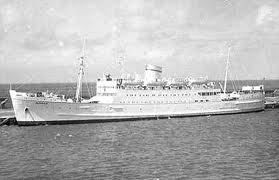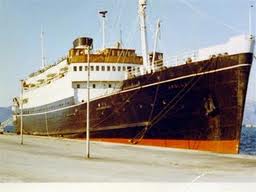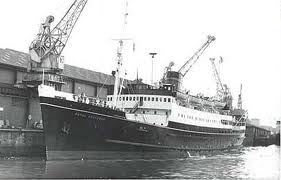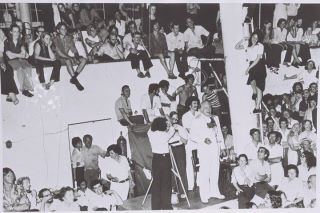Difference between revisions of "Apollo"
(→The Final Days on the Apollo) |
(→The Final Days on the Apollo) |
||
| Line 46: | Line 46: | ||
=== Selling the Ship === | === Selling the Ship === | ||
| + | |||
| + | During that time we had a parade of potential buyers come out to look at the ship. It was a strange group. Who knows where they got their money or even if they had any? The SO mission dug up their own prospects from who knows where. In the very beginning, I think the mission made contact with a {https://en.wikipedia.org/wiki/Broker '''broker'''] in [https://en.wikipedia.org/wiki/New_York '''New York'''] but decided to go it on their own. Part of that decision was based on a perceived need for "secrecy." Every couple of months someone would come out to tour the ship. In the end, when they decided to scrap the ship, they went back to the broker and he knew everyone who had visited and how much money was being discussed. | ||
| + | |||
| + | Eventually, we got about $125,000 for the ship. That was less than the cost of maintaining it for two years. This was particularly frustrating because it provided no direct benefit to the SO and we felt like we wasted two years. | ||
| + | |||
| + | === Other projects: === | ||
| + | |||
| + | *** We managed to restore Mary Sue's Mini that had been dumped in the harbor at [https://en.wikipedia.org/wiki/Madeira '''Madeira'''] and using the Sea Sled on the aft [https://en.wikipedia.org/wiki/Well_deck '''well deck'''] managed to get it ashore. | ||
== <center>Picture Gallery</center> == | == <center>Picture Gallery</center> == | ||
Revision as of 14:39, June 4, 2017
| T.S.M.Y Apollo | |
|---|---|
| Length | 340' |
| Beam | 48' |
| Displacement | |
| Draft | 17' |
| Top Speed | 18 knots |
The Apollo was the main vessel of the Sea OrgAbbreviation for Sea Organization. (Modern Management Technology Defined (C) 1976).![]() . It was bought in October of 1967 and sold in 1975.
. It was bought in October of 1967 and sold in 1975.
For a history of it's wartime service click here.
Contents
The Final Days on the Apollo
By Paul Kawaller
The majority of the contents of the Apollo were removed in Curacao and shipped north to Daytona. We sailed to New Providence Island (Nassau) in the Bahamas and in October of 1975 made final preparations to mothball the ship and remove the remainder of the crew and all Scientology materials. The ship was anchored in South West Bay in about 60 feet of water. As the ship swung on the anchor chain the aft section was not far from the Tongue of the Ocean, which dropped off to 3600 ft.
The crew departed in December of 1975 leaving seven of us behind. Dave Murphy was the Captain of the ship keeping crew as we were known. The remaining members were Jonah Harris, Gary Press, Jim Neal, Ron Morris and myself. There was another crew member who blew-v. ''Slang'' unauthorized departure from an area. (HCOB 19 Jun 71 II)![]() from Nassau while on liberty. I don't recall his name. All in this group were engineers except for me. I was working on deck during the transition to the land base. I volunteered for the assignment. As the crew left I was told that the duration would be about three months, but I didn't believe that. I assumed that we would be there for at least six months. With everything going on, I expected at least six months. As it turns out, it was almost two years before we departed the Bahamas. At the time the crew left very few people that they were going to Daytona, and we did not learn about Clearwater for a very long time.
from Nassau while on liberty. I don't recall his name. All in this group were engineers except for me. I was working on deck during the transition to the land base. I volunteered for the assignment. As the crew left I was told that the duration would be about three months, but I didn't believe that. I assumed that we would be there for at least six months. With everything going on, I expected at least six months. As it turns out, it was almost two years before we departed the Bahamas. At the time the crew left very few people that they were going to Daytona, and we did not learn about Clearwater for a very long time.
With the crew gone, it took a while for us to settle into a routine. Murphy needed to get com-lines established and funding for our activity. We needed to secure things on the ship so that they would need little attention. For transport we initially used the #3 lifeboat for transport because it had a diesel motor. It was a bit dangerous for everyday use however, because when you lowered it you had to crank over the engine by hand to get it started. At the same time someone had to unhook the heavy fall blocks while the boat was rising and falling on the waves. You had to push off from the hull and steer it away from the rubbing strake so you wouldn't get crushed. This is not something we wanted to do forever, so we eventually built a skiff out of plywood and fiberglass and got a Yamaha outboard engine for everyday use. It had only a few inches of freeboard but could plane and was a much better and safer method.
Customs Guards:
We were required to keep a customs guard aboard at all times. These were very amiable men, but obviously didn't have much to do. They stayed with us for about a month at a time and filled us in on whatever gossip there was about the government and the island. Early on, one of them told us that he heard that there were people who wanted to buy the ship. Murphy relayed this to management and that was the start of the saga to sell the ship. Somehow a number of 1.2 Million dollars was set, based on a rumor, not reality. Within a month or so a mission was assigned to sell the ship with two missionaires. I don't recall their names and it's probably better that I don't. I don't know any of the management details. Murphy was our sole contact with the Flag Land Base and was responsible for reporting to management.
Daily Routine:
It was decided that we would work to renovate certain areas of the ship to demonstrate what could be done with it. The usual procedure for touching up the ship for years had been to chip rusty areas by hand, use red lead for primer and to paint over with white paint. We decided to work on the poop deck and chipped the entire thing down to bare metal and primed and painted it. This took months of work. All the rails and all the doors on the ship were stripped and varnished. We worked a full sea org day of 12 hours for the entire time. We had liberty every two weeks and study time. Since there were no courses, I took the opportunity to read all of the LRHL. Ron Hubbard books. We were allotted an extra $5 per week hazard pay, making a grand total of $15/week. I found out early on that the snipes almost never spent their own money, so I decided to do the same. By the end of ship keeping, I managed to save $1,500 on Sea OrgAbbreviation for Sea Organization. (Modern Management Technology Defined (C) 1976).![]() pay.
pay.
South West Bay was remote and we were pretty isolated from the outside world. Being the only substantial ship in the area, from time to time we found ourselves involved in sea rescue. During our two years, we rescued eighteen people in various kinds of trouble. It seems that many sailed (or motored) out from Miami without making sure their boats were seaworthy or even had gas. Sometimes it was local fishermen in trouble.
During that time a James Bond film was shot in the bay. There's a scene in Thunderball where a tanker is part of a fight scene. They used a forty-foot model and set it on fire, blew-v. ''Slang'' unauthorized departure from an area. (HCOB 19 Jun 71 II)![]() it up and sank and raised it several times. It was fascinating to watchEvery member of a ship's company has two general types of activities, one of these is as a member of watches, wherein he handles his duties of steering, lookout, engines, etc., including emergency drills. (FO 1109)
it up and sank and raised it several times. It was fascinating to watchEvery member of a ship's company has two general types of activities, one of these is as a member of watches, wherein he handles his duties of steering, lookout, engines, etc., including emergency drills. (FO 1109)![]() .
.
If you google images of this area today, you will see luxury resorts, marinas, and homes. It was not like this in 1975.
The initial shore transportation was by motorcycle, but Dave Murphy and Gary Press were riding together one day and took a bad spill and got scraped up. That was when Dave decided to restore the mini. We had an interesting time loading it into the sea sled. We couldn't take it ashore at the dock but had to motor around the island until we could make landfall. The Chrysler outboards on the sled were notoriously undependable, so we had to accompany it with two other boats in casethe whole sum of past by-passed charge. (HCOB 19 Aug 63)![]() there was trouble.
there was trouble.
Selling the Ship
During that time we had a parade of potential buyers come out to look at the ship. It was a strange group. Who knows where they got their money or even if they had any? The SOAbbreviation for Sea Organization. (Modern Management Technology Defined (C) 1976).![]() mission dug up their own prospects from who knows where. In the very beginning, I think the mission made contact with a {https://en.wikipedia.org/wiki/Broker broker] in New York but decided to go it on their own. Part of that decision was based on a perceived need for "secrecy." Every couple of months someone would come out to tour the ship. In the end, when they decided to scrap the ship, they went back to the broker and he knew everyone who had visited and how much money was being discussed.
mission dug up their own prospects from who knows where. In the very beginning, I think the mission made contact with a {https://en.wikipedia.org/wiki/Broker broker] in New York but decided to go it on their own. Part of that decision was based on a perceived need for "secrecy." Every couple of months someone would come out to tour the ship. In the end, when they decided to scrap the ship, they went back to the broker and he knew everyone who had visited and how much money was being discussed.
Eventually, we got about $125,000 for the ship. That was less than the cost of maintaining it for two years. This was particularly frustrating because it provided no direct benefit to the SOAbbreviation for Sea Organization. (Modern Management Technology Defined (C) 1976).![]() and we felt like we wasted two years.
and we felt like we wasted two years.
Other projects:
Picture Gallery
File Usage
This page links to the following file;



